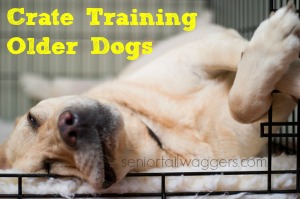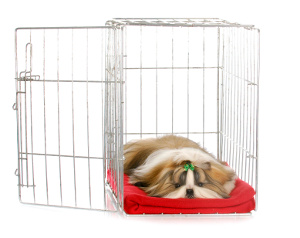This article was updated on April 5th, 2022
Crate training an older dog follows the same general ‘rules’ as it does with puppies – and thanks to Fido’s natural den instincts it comes naturally to most dogs.

There’s also the added benefit that an adult dog usually has reasonably realiable bladder and bowel control.
If you’re trying to potty train an older dog, using a crate will make the whole process a LOT quicker, and easier on everyone.
Crating your dog reduces the chance that he will have an ‘potty accident’.
It also means that he’ll start learning the right habits from day one.
A crate is also a great way to give a senior dog the peace and quiet he needs for those frequent naps.
Plus, if he’s prone to anxiety, or has grown over-sensitive to noise or the ‘busy-ness’ of family life, his crate can be a safe haven where Fido gets to relax and just ‘chill’.
Use these links to jump to:
Choosing A Crate For Your Dog
Let’s start with making sure you have the right type and size of crate for your (and Fido’s) needs…..
Crates For Potty Training Older Dogs
If your dog hasn’t mastered the art of housebreaking yet, the there are two important things you need to do…
- Choose a crate which is easy to clean
- Make sure that it’s not too big
Plastic crates are the best option for this purpose. They’re fully washable, and are usually simple to take apart and reassemble if need be.
When it comes to size, you want the one you choose to be just big enough for Fido to stand up, sit down, lie down and turn around – without touching the sides or top.
That’s it. No bigger. If you choose a crate with ‘extra’ space you increase the chance that your dog won’t have any qualms about peeing or pooping in it.
This is because a dog’s natural ‘den’ instinct makes him reluctant to eliminate where he sleeps, and where he can’t avoid stepping in or sleeping in his urine/feces.
BUT, if he has enough space to designate part of it as his ‘bathroom’ and another part as his ‘bedroom’ – then all bets are off.
Wire crates can be used for house-training older dogs too, but they’re more tricky to get clean and don’t feel as much like a ‘den’ as the more enclosed styles do.
Some dogs like them, some don’t. It’s a personality thing!
The only thing that should be inside the crate (other than your dog) is one or two safe, sturdy chew toys to keep him busy. No food or water bowl, bedding or soft toys (he’s likely to pee on the bed/soft toys) and food or water only stimulates his digestive system.
Crates For Containment & Security
If you’re crate training an older dog who is already house-trained, and isn’t a ‘chewer’, then the choices for crates opens up dramatically.
The popular plastic models are still the most economical and practical choice, but wire crates are a good option as well.
Then there’s the whole range of ‘crate furniture’, which are basically crates that have been designed to be less of an eyesore in the average living room 🙂
Actually, some of them are nicer than the furniture I have in my living room right now!
Available in a variety of ‘looks’ from traditional to modern, and in a range of different materials including fabric, wicker and wood, these are at the higher end of the price scale.
BUT, if you have an senior dog and want ‘his’ favorite spot to fit with your decor or just to spoil him a little, one of these might be just what you’re looking for.
If your dog is already potty trained he can have bedding, a crate pad, or soft toys (assuming he’s not a big chewer, if he is, you might be better without stuff he’s going to destroy!).
A couple of sturdy chew toys are a ‘must’ to head off boredom and let him work off excess energy.
How To Crate Train A Dog
For the purposes of this page, I’ll assume that your dog hasn’t been crated regularly before.
If he IS familiar with being in a crate, then you’ll be ahead of the game 🙂
Introducing Your Dog To His Crate
Most dogs grow to love their crates and will go into them of their own free will whenever they want a nap, or just some ‘quiet time’….. but this won’t necessarily be true right from day one.
If your senior dog isn’t familiar with being crated, you need to start off slowly and keep all interactions light-hearted, positive and fun.
Each dog is different and some take to confinement much faster than others. This introduction period could take as little as a few hours, or as long as a week or more.
You don’t want him build up negative feelings about his crate, so don’t just push him inside, close the door and walk away!
Instead, make it fun by throwing a tasty treat to the back of the crate and allowing Fido to go inside to retrieve it and come right back out again. Repeat this three times then change to another activity.
Come back an hour or so later and do the whole thing all over again, and KEEP doing it until your dog goes in and out of the crate without any signs of anxiety or worry.
You can also try feeding him in his crate.
Some dogs will chow down anywhere, others get anxious when the food bowl isn’t in the usual spot. It’s just trial-and-error to find out how your dog reacts.
Once Fido is happy to go into his crate after a treat, throw in a safe, sturdy chew toy as well and start closing the door on him for a few seconds.
What I do is to offer a second treat to the dog through the wire door panel once he’s turned around. Tell him ‘Good dog’. Good crate.’ or something similar. After a few seconds you can let him out.
Practice this regularly, gradually extending the amount of time you leave the crate door closed – and begin to move away from it slowly and calmly. The aim is to get Fido to feel comfortable staying in his crate for reasonable periods of time.
If you’re not house-training your dog, once you get to the stage where he’s happy to nap/play/rest in his crate for an hour or two you’ve reached your goal.
From now on it’s just a matter of using the crate in a positive way, and remembering that it’s a tool to make life easier and less stressful for both of you…
… NOT a ‘dog-sitter’, punishment or isolation chamber.
If you ARE trying to potty train your dog, keep reading 🙂
The Basics
The two most important things about crate training an older dog (or a dog of any age!) are….
- It drastically reduces the opportunity for ‘potty accidents’
- Gets your dog in the habit of eliminating in the designated spot
These are key, and are 99% of the battle.
But, you need to use the crate properly if Fido is going to get the hang of this potty training thing quickly.
This is really very simple, and very effective, as long as you follow some simple guidelines:
Don’t crate your dog for longer than he can comfortably ‘hold it’
With puppies and senior dogs this might be as little as 30 minutes, healthy adult dogs can usually manage several hours.
ALL dogs need regular breaks so they can pee/poop, and for exercise, fun and to spend time with their family.
Always supervise your dog when he’s not in his crate
This is hugely important!
While he’s crated Fido is going to try hard to ‘hold it’, so when you take him out of his crate it’s very important to get him to his designated potty spot right away.
But, when he’s allowed free-run of the house, his den-instinct won’t kick in and that means he’ll feel okay about eliminating just about anywhere. You need to watch him like a hawk to make sure that doesn’t happen.
Every ‘mistake’ makes learning the right behavior take a little longer to become a habit. If he has potty-training accidents regularly, your dog could get really confused, which is NOT what you want.
Set up a predictable routine, and stick to it
Dogs are creatures of habit and they thrive on routine. Older dogs especially NEED their days to be predictable in order to feel safe and calm.
When you’re crate training your older dog, make sure the majority of days follow the same pattern of meals, crate time, play time, naps, exercise and love-on-Fido time.
Scroll down to check out my suggested crate training schedule for adult dogs.
Don’t allow Fido to call the shots
Although most dogs accept or enjoy crate-time, sometimes they just want an extra 10 minutes of play, or to be right next to you.
This is normal, but it’s important that you don’t let Fido out of his crate just because he’s decided that it’s time for his walk.
Dogs, like kids, need the security of guidelines, boundaries and an authority figure.
Although he might throw a fit at first, your dog will soon learn that you decide when things happen and he’ll stop fussing to get out of his crate whenever he feels like it.
* There is an exception to this, and that’s for dogs who are suffering from separation anxiety, or are very nervous or easily scared. If your dog gets hysterical at being crated or left alone, especially if he’s a senior dog, then you may need to rethink this strategy.
Schedule For Crate Training An Older Dog
If you’re using a crate for containment only, and your dog is already house-trained, then you really don’t need a schedule – or at least you don’t need one from me!
That’s because as long as you use the crate sensibly and make sure Fido gets plenty of crate-free time, exercise and ‘loving time’, you can set up whatever daily routine works best for your needs.
But please remember, no dog should be crated for more than 6 – 8 hours (absolute maximum) on a daily basis.
Even fully potty-trained senior dogs may have trouble controlling their bladder for that long. Plus Fido may get lonely or anxious which can lead to behavior problems.
If your dog is small to medium sized, you might want to also try a doggie play-pen (also known as an X-pen) as an extra potty training tool.
By arranging the pen to make the enclosed area small enough you can give your dog a change of scenery without messing up (sorry for the pun!) his house-training lessons.
X-pens also make a good alternative to a crate for dogs who get very anxious in enclosed places or who refuse to adjust to one. This is rare, but it happens.
If you’re using the crate as a house-training tool for your older dog, then a regular daily routine can make life easier.
No two families are the same, so there’s no one-size-fits-all crate training schedule, but here’s a sample that you can adjust to suit your own life:
First thing in the morning – take Fido outside to pee/poop as soon as he’s awake.
Some dogs need to eliminate more than once first thing, so give him time for an ‘instant-replay’ and don’t assume he’s finished after one squat.
Bring him back indoors and put him in his crate while you get ready for the day and eat breakfast.
After breakfast – now it’s time for your dog to have his breakfast. Then he’ll need another trip outside to his potty spot.
A little exercise can get his bowels moving if he hasn’t pooped yet.
Once he’s done his business bring him back indoors and he can have free-time in the house as long as you’re watching him closely.
Signs he needs to ‘go’ include intense sniffing, circling and eventually squatting. Some dogs will try to creep away to pee behind the sofa or under the table.
If Fido is looking ‘furtive’ – he just might need to go outside again!
Mid-morning – take your dog outside for another potty break, then crate him with a favorite chew toy for some ‘alone time’.
After-lunch – another potty break, then some exercise and/or play. If you have a senior dog this might be a leisurely stroll down the street… or only as far as the mailbox.. anything is better than nothing and helps keeps joints mobile.
Then more free time in the house with you watching, or tether your dog to you and go about your business… or if you have an X-pen or doggie playpen, he could spend some time in there as long as it’s in the same room as you and you’re watching for ‘potty signals’.
Late-afternoon – potty break, crate time.
Evening – potty break, dinner, potty break. Play time, lap time, TV time… however you spend your evenings. Just keep an eye on your dog to make sure he doesn’t need to ‘go’.
Before bed – make sure Fido has a potty break before everyone goes to bed. If you like him to sleep on the bed, just be sure to take him outside as soon as he wakes up in the morning. Otherwise damp sheets, or a puddle on the carpet are very possible.
If he sleeps in a crate, it’s night-night time now.
* Most adult dogs can hold their urine overnight, but some older dogs have weak bladders or suffer from incontinence and may need a trip to their potty spot before morning.
Try ‘Tethering’
If you find it difficult to watch Fido’s every move because you’re busy or moving from room to room, you can ‘tether’ him to you.
Most dogs won’t eliminate if they’re right next to you, so fix a long training leash (or a piece of rope) to his collar and then attach it to your belt or around your waist.
Your dog will now have to follow you wherever you go.
Obviously you’ll still need to be on the lookout for ‘potty signals’ but tethering means he can’t creep off for a minute and make a mess.
Crate Training Tips
- Don’t expect overnight results. If your older dog has spent his whole life eliminating wherever, and whenever, he feels like it, this habit will be pretty firmly established in his mind and body. Adult dogs take a bit longer to learn the right habits because they’re having to UN-learn the wrong ones at the same time!
- Keep your expectations realistic. If you expect too much when you’re crate training an older dog, you’ll be disappointed, even frustrated. That won’t help your crate training efforts. Before you start, realize that this process is going to take some time, and there will be mistakes along the way. But, that you, and Fido, will succeed, together.
- Patience and consistency are the keys to success. If there are two things which are absolutely crucial to successfully crate training an older dog they are patience and consistency. Be consistent about where you take your dog to eliminate, and when. He will grow to expect the daily routine you set up and that will help regulate his bodily functions.Be patient because Fido wants to please you, he just has no idea what it is you want, or why. Be extra-patient because he’ll need lots of practice, and will probably make a few mistakes, before he ‘gets it’. But he will get it.
- Use lots of praise. When your dog does his business in the right place, be sure to give him lots of praise and encouragement. He needs to know that he’s been a good boy. A tasty treat doesn’t hurt now and then either 🙂
- Don’t punish accidents, especially after the fact. On the flip-side, don’t punish him if he makes a mistake. If you’re doing things right there should be very few of these, and if he’s had the opportunity to have an ‘accident’, chances are you weren’t watching him closely enough.If you catch him in the act, you might be able to stop him from peeing/pooping by clapping loudly, then tell him ‘NO’ firmly and get him outside to his potty spot right away. Even if he still finishes peeing after you’ve clapped, still tell him ‘No’ and get him outdoors.
- Make sure you clean up accidents thoroughly. Clean up the area using an enzymatic cleaner, to remove all traces of the odors that otherwise linger and will draw your dog back to eliminate in the same spot later. Then and move on. Mistakes happen. Just keep practicing and perhaps increase your surveillance tactics!
- Pick a good location. The main things to consider for the location of your dog crate is comfort, practicality and safety. Keep away from heavy traffic areas, toxic plants and warm or cold spots or where your dog will feel isolated. A good spot is your bedroom or living room.
Disclaimer: This website's content is not a substitute for veterinary care. Always consult with your veterinarian for healthcare decisions. Read More.




Be the first to comment